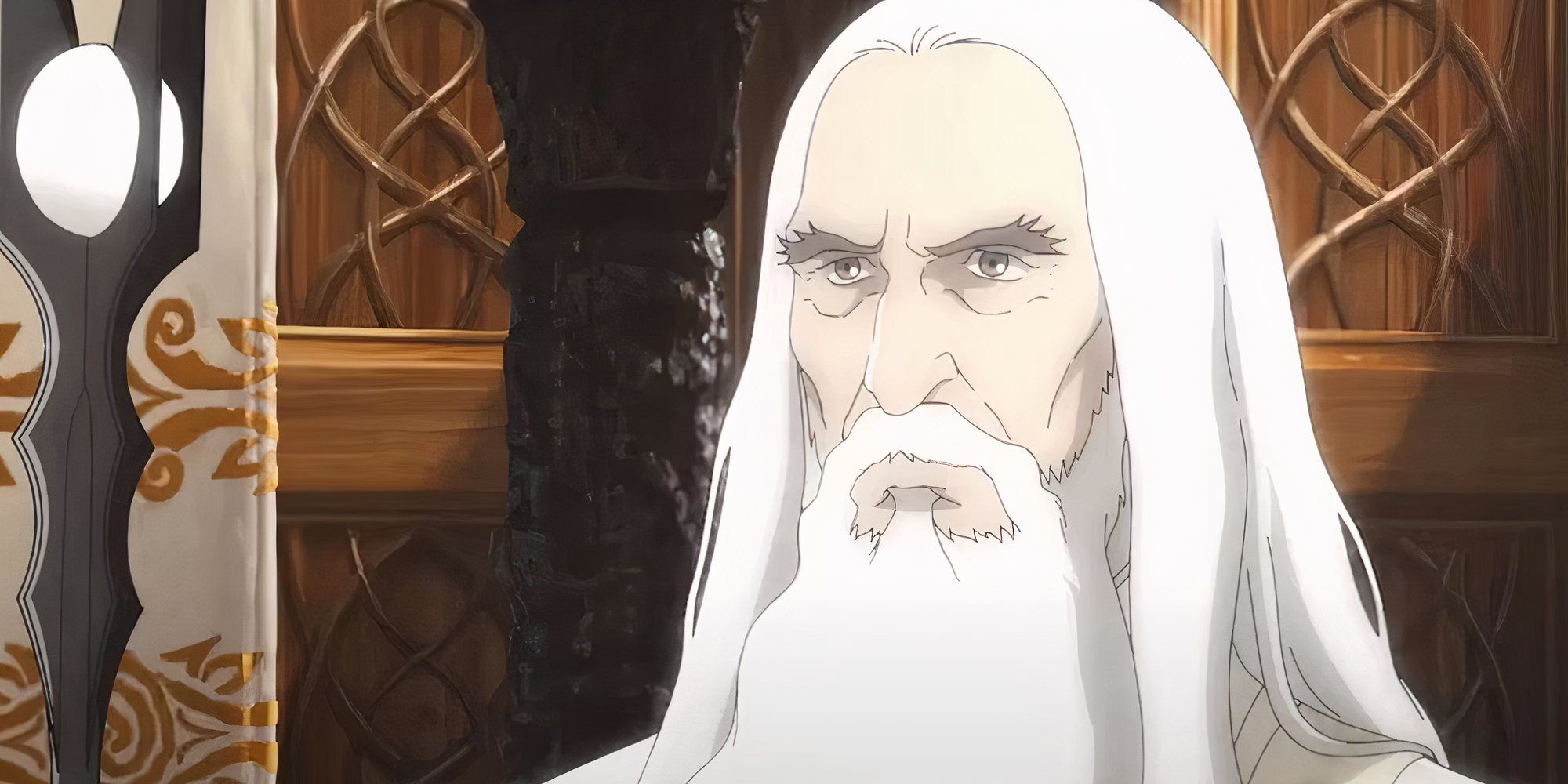
After a long winter and siege cornered at the Hornburg, Helm Hammerhand makes a final stand, defending the keep and his people with his bare fists, killing Wulf’s men as he eventually freezes to death. Despite matters growing dire, the Rohirrim, under Héra’s leadership, eventually withstand Wulf’s army of Dunlendings. War of the Rohirrim’s story ends with Héra’s defeat of Wulf and the crowning of a new king, Fréaláf Hildeson.
Héra’s Plan To Defeat Wulf & Their Final Fight Explained
Héra Distracts Wulf With A Duel Long Enough For Help To Arrive










Héra defeating Wulf comes from intimately knowing her enemy and understanding the type of leader Wulf has become. Throughout the siege, Wulf’s people are beginning to starve, and though their situation isn’t as dire as Héra’s, they’re still on the verge of turning on him. Héra knows that Wulf is maintaining his siege because of her and that she can ride out to distract him as her people escape through the hidden passageway in the fortress. She rides her horse out onto the bridge of Wulf’s siege tower and challenges him to single combat.
Fréaláf takes up the crown as the new King of Rohan, leading his soldiers to aid his people
Wulf ignores General Targg’s advice and accepts Héra’s duel, eventually losing to her. Héra also requested help from the giant eagle nesting in the mountain above the Hornburg, who carried Helm Hammerhand’s crown to Héra’s cousin Fréaláf. Fréaláf takes up the crown as the new King of Rohan, leading his soldiers to aid his people despite previously being dismissed. Héra defeats Wulf, while Fréaláf defeats Wulf’s army, ending the conflict in their favor.
Where Héra Goes In War Of The Rohirrim’s Ending
Héra Goes Off On Adventures With Gandalf

Héra ends the conflict of War of the Rohirrim as a hero to her people. However, with Fréaláf crowned as king, she’s no longer needed as a leader in Rohan. She receives a letter requesting her aid in matters likely related to Sauron’s potential return, and it is revealed that the letter is from Gandalf. As one of the Istari, Gandalf’s purpose on Middle-earth is to combat the threat of Sauron, and it’s shown earlier in the film that a pair of orcs were traveling in search of rings.
War of the Rohirrim takes place hundreds of years before the War of the Ring, but it’s clear that both sides have already begun searching for the One Ring. Gandalf enlists Héra to support him in tasks related to the discovery of the One Ring, similar to how he does with Aragorn prior to The Fellowship of the Ring. Essentially, the scene demonstrates that Gandalf is privy to Héra’s valor and wants her help.
Saruman’s Appearance & Acquisition Of Isengard Explained
Christopher Lee’s Voice Is Used For A Saruman Cameo

War of the Rohirrim’s Saruman cameo is brief but has important implications for The Two Towers and is based on a moment from Tolkien’s lore. Notably, the cameo used recordings of Christopher Lee’s voice taken from The Hobbit movies, allowing the late great actor, who passed away in 2015, one last performance as the iconic wizard. Saruman arrives and is granted the fortress of Isengard, previously used by Wulf in the movie, and it becomes the wizard’s seat of power that he utilizes throughout The Lord of the Rings.
Fréaláf has a distrusting look on his face as the White Wizard approaches and offers his assistance to Rohan. This foreshadows Saruman’s later betrayal of the Rohirrim during the One Ring when he raises an army of Uruk-hai to invade Rohan. The moment of Saruman’s arrival is mentioned in the Appendices of The Return of the King, under Appendix A’s section “The House of Eorl.” The book mentions that he arrives bearing gifts and praising the valor of the Rohirrim, essentially sweet-talking his way into the prize of Isengard. Read the full passage below:
It was at the crowning of Fréaláf that Saruman appeared, bringing gifts, and speaking great praise of the valour of the Rohirrim. All thought him a welcome guest. Soon after he took up his abode in Isengard. For this, Beren, Steward of Gondor, gave him leave, for Gondor still claimed Isengard as a fortress of its realm, and not part of Rohan. Beren also gave into Saruman’s keeping the keys of Orthanc. That tower no enemy had been able to harm or to enter.
In this way Saruman began to behave as a lord of Men; for at first he held Isengard as a lieutenant of the Steward and warden of the tower. But Fréaláf was as glad as Beren to have this so, and to know that Isengard was in the hands of a strong friend. A friend he long seemed, and maybe in the beginning he was one in truth. Though afterwards there was little doubt in men’s minds that Saruman went to Isengard in hope to find the Stone still there, and with the purpose of building up a power of his own. Certainly after the last White Council (2953) his designs towards Rohan, though he hid them, were evil. He then took Isengard for his own and began to make it a place of guarded strength and fear, as though to rival the Barad-dûr. His friends appendix a 1401 and servants he drew then from all who hated Gondor and Rohan, whether Men or other creatures more evil.
How Accurate War Of The Rohirrim Is To Tolkien’s Lore
Héra Is Barely A Character In J.R.R. Tolkien’s Writings

War of the Rohirrim’s story comes from the appendices of The Return of the King, though there are some major elements added to the film that aren’t in the text. First off, the conflict between Helm and Freca is drawn directly from the appendices, with Tolkien writing, “(Helm) smote Freca such a blow with his fist that he fell back stunned, and died soon after.” This later leads to the war between Helm and Wulf, with Helm dying the same way he does in the movie. However, it’s Fréaláf who’s solely credited with the victory thereafter.
The most significant addition to War of the Rohirrim is Héra. It’s mentioned in the text that Helm has a daughter, and Freca wants to wed Wulf to her, but she’s never named. The shield-maidens of Rohan are also a made-up faction for the movie, inspired by Éowyn from The Lord of the Rings, as she’s commonly described using this term. Héra leading the Rohirrim through the long winter is written entirely for the movie, and it’s why the film suggests she was left out of the “history books.”
How War Of The Rohirrim Sets Up A Sequel & Gandalf’s Appearance
A Sequel Could Follow Héra’s Quest With Gandalf

A War of the Rohirrim sequel isn’t currently planned, but given Warner Bros.’s desire to make more Lord of the Rings films and Peter Jackson coming on as a producer late in the movie’s process, it’s not impossible. The film lays the foundation for more of Héra’s adventures, possibly even including Ian McKellen’s Gandalf, though these would be going into completely uncharted territory with no narrative backing from Tolkien’s writing. It likely depends on the critical reception and, more importantly, the financial success of the first movie.
The Real Meaning Of War Of The Rohirrim Explained
War Of The Rohirrim Is About A Forgotten Middle-earth Hero

War of the Rohirrim is a tale about an unsung hero in J.R.R. Tolkien’s Middle-earth. It’s vital that the film is narrated by Miranda Otto’s Éowyn, a woman who mirrors Héra’s story in many ways as a daughter of a King of Rohan with a desire to fight and defend her people. Éowyn looks up to Héra, and in the same way that Kamiyama wishes to tell this “forgotten tale,” Éowyn also wants to share the story of a powerful, headstrong woman who was a hero to her people.
Like The Lord of the Rings, War of the Rohirrim is a story about honor, valor, and camaraderie in war. However, it’s also a tale about gender roles in historical legacy. In the version of Tolkien’s world that Kamiyama paints, Helm Hammerhand, his sons, and his nephew are celebrated as great leaders and heroes when it was really Héra whose bravery inspired her people and won the day.





